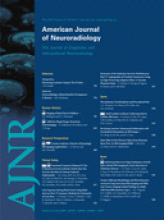Research ArticleNeurointervention
Open Access
Percutaneous Sclerotherapy for Facial Venous Malformations: Subjective Clinical and Objective MR Imaging Follow-Up Results
J. Spence, T. Krings, K.G. terBrugge, L.B. da Costa and R. Agid
American Journal of Neuroradiology May 2010, 31 (5) 955-960; DOI: https://doi.org/10.3174/ajnr.A1940
J. Spence
T. Krings
K.G. terBrugge
L.B. da Costa

References
- 1.↵
- 2.↵
- 3.↵
- Goyal M,
- Cause PA,
- Armstrong D
- 4.↵
- Dubois J,
- Soulez G,
- Oliva VL,
- et al
- 5.↵
- Hyodoh H,
- Hori M,
- Akiba H,
- et al
- 6.↵
- 7.↵
- Muir T,
- Kirsten M,
- Fourie P,
- et al
- 8.↵
- 9.↵
- 10.↵
- Tan KT,
- Kirby J,
- Rajan D,
- et al
- 11.↵
- Kaban L,
- Mulliken JB
- 12.↵
- 13.↵
- Ionescu G,
- Mabeta P,
- Dippenaar N,
- et al
- 14.↵
- 15.↵
In this issue
Advertisement
J. Spence, T. Krings, K.G. terBrugge, L.B. da Costa, R. Agid
Percutaneous Sclerotherapy for Facial Venous Malformations: Subjective Clinical and Objective MR Imaging Follow-Up Results
American Journal of Neuroradiology May 2010, 31 (5) 955-960; DOI: 10.3174/ajnr.A1940
0 Responses
Jump to section
Related Articles
- No related articles found.
Cited By...
- Bleomycin sclerotherapy for venous vascular malformations of the tongue
- Lymphographic-Like Technique for the Treatment of Microcystic Lymphatic Malformation Components of <3 mm
- Guidelines and parameters: percutaneous sclerotherapy for the treatment of head and neck venous and lymphatic malformations
- Low-flow vascular malformations of the head and neck: clinicopathology and image guided therapy
This article has not yet been cited by articles in journals that are participating in Crossref Cited-by Linking.
More in this TOC Section
Similar Articles
Advertisement











